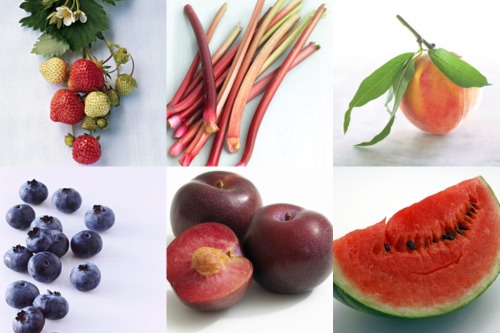STRAWBERRIES
How to Buy
Strawberries vary in size, shape, and color. Look for locally grown berries that are brightly colored and plump. They should have the green caps attached and be uniform in size. Avoid soft, shriveled, or moldy fruits. If the strawberries smell sweet, they will most likely taste sweet too.
How to Store
Sort and remove any bruised or damaged berries as soon as possible. Do not rinse fruits until you are ready to use them. Refrigerate strawberries in a tightly sealed container, preferably in a single layer on a paper towel, for two to three days.
RHUBARB
Rhubarb has long, thick stalks, similar to celery. There are two main types of rhubarb: hothouse, which is grown indoors and sold year-round, and field-grown, which has a bit more flavor and is available from April to July.
How to Buy
Rhubarb ranges in color from deep red to pinkish tinged with green. Choose crisp stalks that are about an inch wide, with no brown spots.
How to Store
Refrigerate in a plastic bag for up to one week.
How It’s Used
Because it’s very tart, rhubarb is always cooked with sugar (or other sweetener). It is often combined with red fruits, such as strawberries or raspberries, to enhance the color and complement the flavor.
How to Prepare
Rinse well, then trim the bottoms and tops. If there are any leaves, slice off and discard (they are toxic). If the stalks are stringy, remove with a small paring knife, as you would for celery.
PEACHES
How to Buy
July and August are prime time for peaches. Choose fruit with a fragrant aroma and flesh that yields a bit when pressed gently. If a peach has cuts or tan spots, or if it’s rock-hard or mushy, don’t buy it. Color has more to do with variety than ripeness. Peaches that are tinged with green, however, are usually underripe. For the best flavor, look for locally grown, tree-ripened peaches.
How to Ripen
Place peaches in a paper bag, with an apple, if you have one. Keep them at room temperature until they’re ready, and check them frequently.
How to Store
Ripe peaches are best eaten right away, but you can refrigerate them for three to five days.
BLUEBERRIES
How to Buy
You can find cultivated berries all year; wild (and locally grown) berries are available primarily during July and August. Wild blueberries are much smaller and often more intensely flavored than cultivated ones. The berries should be firm, uniform in size, and deep blue in color, with a silvery or white sheen. Avoid any packages that appear stained or damp, as the fruit inside may be spoiled.
How to Store
Remove any twigs or leaves along with any berries that are soft or moldy. Refrigerate in the original container up to five days. When you’re ready to use them, rinse berries under cold water; drain and pat dry.
How to Freeze
Spread rinsed and dried berries on a rimmed baking sheet; freeze until firm, one hour. Transfer to resealable plastic bags (label and date); store up to six months.
PLUMS
Plums are cultivated in temperate regions all around the world. They come in a wide range of sizes, colors, and tastes; more than 100 varieties are sold in the United States alone. Most types of plums are grown for eating out of hand. Others, selected for their high level of sugar, are cultivated to be dried; they’re then called dried plums or prunes.
How to Buy
Domestic plums are crimson to black-red with a yellow or reddish flesh; they are in season May through October. European varieties, which peak during the fall months, range from green to blue to purple and have a golden yellow flesh. Look for plums that are even in color and plump, yielding gently to pressure. Stay away from fruit with wrinkled or broken skin or extremely soft spots.
How to Ripen
If too firm to use, place in a closed paper bag at room temperature for one to two days.
How to Store
Once ripe, plums can be kept in a plastic bag in the refrigerator up to three days.
MELONS
How to Buy
Look for those that are fragrant and heavy. Press end opposite stem to feel for a bit of give. For watermelon: Avoid those with flat sides. Presliced, it should be deep red with about an inch of white rind.
How to Store
Store whole melons in a cool spot or, if cut, in the refrigerator.
Source: Martha Stewart. View the article on MarthaStewart.com



No comments:
Post a Comment